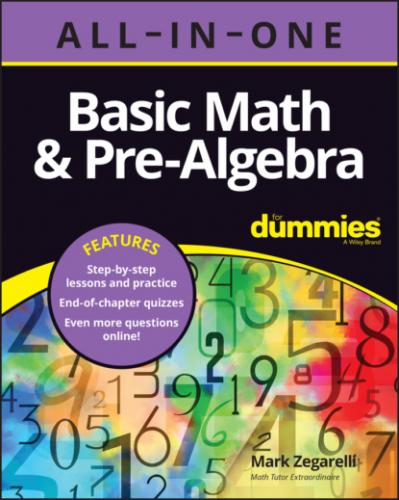One path into this new and often strange world is the number sequence: an arrangement of numbers according to a rule. In the following sections, I introduce you to a variety of number sequences that are useful for making sense of numbers.
Evening the odds
One of the first facts you probably heard about numbers is that all of them are either even or odd. For example, you can split an even number of marbles evenly into two equal piles. But when you try to divide an odd number of marbles the same way, you always have one odd, leftover marble. Here are the first few even numbers:
You can easily keep the sequence of even numbers going as long as you like. Starting with the number 2, keep adding 2 to get the next number.
Similarly, here are the first few odd numbers:
The sequence of odd numbers is just as simple to generate. Starting with the number 1, keep adding 2 to get the next number.
Patterns of even or odd numbers are the simplest number patterns around, which is why kids often figure out the difference between even and odd numbers soon after learning to count.
Counting by threes, fours, fives, and so on
When you get used to the concept of counting by numbers greater than 1, you can run with it. For example, here’s what counting by threes, fours, and fives looks like:
These types of sequences are also useful for understanding factors and multiples, which you get a look at in Chapter 9.
Getting square with square numbers
When you study math, sooner or later, you probably want to use visual aids to help you see what numbers are telling you. (Later in this book, I show you how one picture can be worth a thousand numbers when I discuss geometry in Chapter 19 and graphing in Chapter 25.)
The tastiest visual aids you’ll ever find are those little square cheese-flavored crackers. (You probably have a box sitting somewhere in the pantry. If not, saltine crackers or any other square food works just as well.) Shake a bunch out of a box and place the little squares together to make bigger squares. Figure 1-1 shows the first few.
© John Wiley & Sons, Inc.
FIGURE 1-1: Square numbers.
Voilà! The square numbers:
Square numbers are also a great first step on the way to understanding exponents, which I introduce later in this chapter and explain in more detail in Chapter 5.
Composing yourself with composite numbers
Some numbers can be placed in rectangular patterns. Mathematicians probably should call numbers like these “rectangular numbers,” but instead they chose the term composite numbers. For example, 12 is a composite number because you can place 12 objects in rectangles of two different shapes, as in Figure 1-2.
© John Wiley & Sons, Inc.
FIGURE 1-2: The number 12 laid out in two rectangular patterns.
As with square numbers, arranging numbers in visual patterns like this tells you something about how multiplication works. In this case, by counting the sides of both rectangles, you find out the following:
Similarly, other numbers such as 8 and 15 can also be arranged in rectangles, as in Figure 1-3.
As you can see, both these numbers are quite happy being placed in boxes with at least two rows and two columns. And these visual patterns show this:
© John Wiley & Sons, Inc.
FIGURE 1-3: Composite numbers, such as 8 and 15, can form rectangles.
The word composite means that these numbers are composed of smaller numbers. For example, the number 15 is composed of 3 and 5 — that is, when you multiply these two smaller numbers, you get 15. Here are all the composite numbers from 1 to 16:
Notice that all the square numbers (see the section, “Getting square with square numbers”) also count as composite numbers because you can arrange them in boxes with at least two rows and two columns. Additionally, a lot of other non-square numbers are also composite numbers.
Stepping out of the box with prime numbers
Some numbers are stubborn. Like certain people you may know, these numbers — called prime numbers — resist being placed in any sort of a box. Look at how Figure 1-4 depicts the number 13, for example.
© John Wiley & Sons, Inc.
